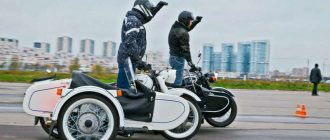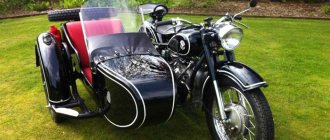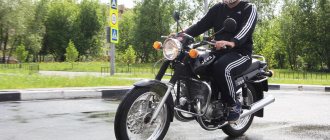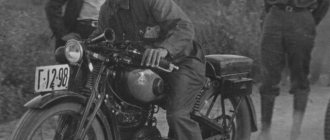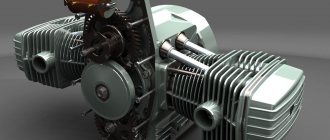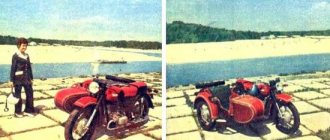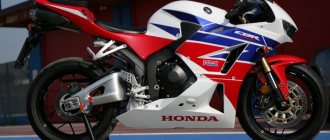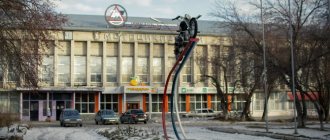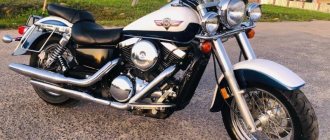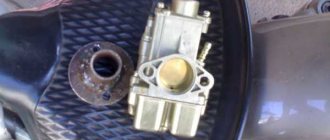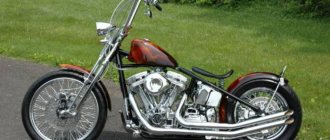The Ural Solo motorcycle, produced back in the 90s, was a slightly redesigned version of the regular IMZ-8.103-10 , only in a single-seat version. This bike, equipped with 650 cc engine, was even supplied to the traffic police (then traffic police), and police officers rode it in the warm season. At the beginning of the 2000s, it was replaced by the Ural Solo Classic with a 750 cc engine , the same one that was installed on the Wolf and Voyage, but it was not too popular. Later, Ural Solo ST and Ural Retro Solo were created, but both were designed primarily for the markets of other countries. Some enthusiasts purchased these models in Russia, but there are only a few of them. And not least because of the high price of these motorcycles, partly due to the use of imported components.
Motorcycle Ural classic (retro) solo st (st)
Ural “Solo-Classic” surprises with its rich color and good balance of painted and chrome-plated parts.
It looks good, as befits a classic motorcycle. The appearance of motorcycles of this class is almost more important than dynamic and driving performance, but it is also interesting to know the characteristics in detail. Price Ural solo - 270,000 rubles. But I doubt that people who have encountered Urals will be interested in the appearance first. Remembering the eternal disease of motorcycles of this brand - constant leaks and oil dripping from all the holes - I looked under the engine. Wow, it's dry! Maybe just new? But until recently it dripped on new ones, causing disgust in any person. Well, let's go for a ride.
Ural solo characteristics
The motorcycle is equipped with an automatic gas tap - no need to open it. The Keihin carburetors are very reassuring, I pressed the starter button and the engine came to life, illuminating those around me with a bass exhaust note. Connoisseurs will approve, how can this be compared to the Japanese 4-cylinder cackle.
One of the advantages of the boxer design is the ability to place the driver's seat lower. This is done so that when stopping, you can rest your entire foot on the ground; this makes it easier to maintain balance, because the motorcycle weighs 230 kg. While I was thinking about the weight distribution of the motorcycle, I forgot to remove the side stand, but it doesn’t matter - it springs back into place on its own. And immediately I got a good impression, the first gear engaged with incredible ease, without clanging, roaring or grinding. Once you start moving, the feeling of heaviness of the motorcycle immediately disappears. As you accelerate, the stability of the motorcycle increases.
I became a little bolder and let go of the steering wheel: the Ural Solo classic went where I wanted, and I corrected the trajectory by slightly tilting the body. At speeds over a hundred, the wheels do not hit. Finally, the factory thought about the consumer and began balancing the wheels, and they survived! But when I got to the first turn, I felt a slight jitter; the back of the motorcycle seemed somehow light, it turned out that it was unloaded. On uneven roads, the shock absorbers fail to cope, and it turns out that the motorcycle drifts off the trajectory. And the suspension itself was not up to par. The front fork is Italian “Paioli”, its characteristics are perfectly chosen, but the rear fork is too stiff. However, you can’t expect much from a short-travel suspension with two shock absorbers. But how the springs of the rear shock absorbers creak! You can compose a lot to this squeak, but I think comfort will increase if you seat a passenger in the back. And some shortcomings can be eliminated by replacing oak rubber.
FAQ
- Are spare parts still available for Solo ST and Retro Solo? Or maybe they fit from other modern Urals? Spare parts are produced at the Irbit plant, but they are rarely available. Often you have to order and wait. Some units are suitable from brothers in the model range.
- Do new bikes not have the problems that ancient boxer bikes are so famous for? Compared to the products of the Irbit plant of Soviet times, the new models are much more reliable, this is an indisputable fact.
- Why are they so expensive? In general, why buy a boxer at the price of a Japanese or American motorcycle? Because they are sold, with rare exceptions, only in the markets of other countries. Only connoisseurs of the brand buy them from us.
Ural Solo sT – classic and ergonomic on two wheels.
Solo sT is a motorcycle that combines the best of the classic Ural - simplicity, versatility and timeless classic lines. It could have been produced in the 70s if Soviet engineers had been allowed to create a two-wheeled motorcycle. It was decided to revive old ideas - thus the Ural Solo sT was released. This motorcycle satisfies the need for functionality, simplicity and intelligence. It is versatile and suitable for both the city and outdoor trips.
Solo sT is a classic motorcycle with modern components: DUCATI microprocessor ignition system, Sachs shock absorbers, Yuasa battery. The Ural Solo sT is equipped with Marzocchi forks and Brembo brakes for comfortable driving.
Reliable, robust and proven, the air-cooled boxer engine features electric start and kickstart, producing 40 hp. at 5600 rpm, torque 5.3 kgm at 4000 rpm.
In 2013, the Ural Solo sT is presented in matte black, which certainly suits it very well.
Similar models
- Triumph Bonneville T100 . A British take on the classics. It's expensive, but the price is justified.
- Kawasaki W650 . A vintage Japanese bike in the best traditions of half a century ago, but with true samurai quality.
- Moto Guzzi V9 Roamer . A stylish guy from sunny Italy, with a transverse V-twin and the inimitable charm of a real gentleman.
Ural Solo
Hai! The Ural Solo motorcycle is not the only model of biker transport that is available on our website. Here you will find the most popular iron horses on the planet. Both domestic and foreign, and no longer produced Soviet bikes are described in detail on All about motorcycles. Here you will find a wealth of information regarding biker organizations and their iron horses.
The Motorcycle News section is especially important. With it you will always be aware of the latest events in the world of two- and three-wheeled steel horses
Description Ural solo and photo
This bike belongs to the class of classic road motorcycles. Moreover, this is one of the most popular IMZ motorcycles. The main advantage of the above two-wheeler is the price. Almost all compatriots can buy Ural Solo. There would be a desire. In addition to the relatively moderate cost, this Irbit iron horse stands out for its excellent style, having a lot of elements of the classic retro style.
The Solo model is equipped with a powerful 650 cc engine. The latter is started using an electronic ignition system. Moreover, the designers also left the winding leg (kick starter).
Among other pleasant technical characteristics of the Ural Solo Classic, a photo of which you will find in this motorcycle review, we can highlight the presence of a disc brake system. Otherwise, the volumetric opposed four-stroke two-cylinder bike from IMZ remained without fundamental changes. Let us also note the rather high power performance of the motorcycle engine. 45 horses for the domestic motorcycle industry is incredible progress, given the lack of proper funding for the production of biker equipment.
Reviews for most products in this line are quite impressive. People are satisfied with the technical characteristics of the two-wheeled IMZ, taking into account the price/quality ratio. With the beginning of the 21st century, this motorcycle received a brand new carburetor as a gift from the manufacturer. The electronics of the iron horse have also undergone many serious changes. The new map of the Urals is available on our website.
According to reviews from owners provided by experienced motorcyclists, the IMZ “Solo” is a fairly reliable and unpretentious steel horse. This two-wheeler is especially pleasant to operate within city limits, where there are high-quality, smooth roads. The Ural “Solo” model, equipped with a chrome-plated gas tank capable of holding 19 liters of fuel, is considered the most beautiful.
For this motorcycle, the speed limit is 130 km/h. With a mass of 235 kilograms, this is a pretty good indicator for a domestic bike that has not undergone radical changes in the design of the engine since the Great Patriotic War.
This motorcycle from IMZ is well controlled and very maneuverable. Riding it provides a classic driver's position, which allows you to travel long distances in comfort. By installing a windshield and fabric seat covers on a two-wheeler, you can get additional comfort on the road.
I would also like to note that this line of the Irbit Motorcycle Plant has received many modifications. One of these is used by the police of the Russian Federation. Ural Retro Solo is a striking example of another successful iron horse of IMZ.
Specifications
The first Ural Solo motorcycles were equipped with an ancient 650 cc 40-horsepower engine, but they are still rarely found on sale. Subsequently, the technical characteristics were improved, and the motorcycle received a 750 cc engine, which was installed on the Ural Solo Classic. At the same time, the bike acquired Brembo brakes, a Japanese carburetor and a host of other imported components.
Engine
The air-cooled boxer engine has not undergone any significant changes over the past two decades, with the exception that in the Ural Retro Solo and the Ural Solo ST it received an injector instead of a carburetor. The engine is powered by 92-octane gasoline and accelerates the bike to 100 km/h in about 10 seconds, reaching a top speed of 120-140 km/h. One of the pleasant moments is the confident traction at the bottom, and the less pleasant ones are the weak dynamics. This disadvantage is especially felt on the highway.
Transmission
The ancient 4-speed transmission has remained virtually unchanged for the past sixty years. The first three gears are relatively short, so you can switch to the top one at 60-70 km/h. Interestingly, the fourth gear ratio is greater than one, which is unusual for most cruisers. But there is a reverse direction! Although on a motorcycle without a sidecar like the Ural Solo Classic it is not really needed.
Chassis and brakes
The frame, rear suspension and driveline have not changed at all over the years. There are Brembo brakes on the front wheel, and the Ural Retro Solo, together with the Solo ST, can boast a similar braking system at the rear. The front fork, imported and reliable, has become much better; compared to the Ural Solo Classic, it’s just heaven and earth! The motorcycle stopped nodding when braking, and the efficiency of the front suspension was equal to the efficiency of the brakes.
Electronics
The Japanese Yuasa battery, a microprocessor ignition system from Ducati and a 500-watt generator have been installed on the motorcycles of the Irbit plant since the end of the 20th century. If the wiring had also been carried out wisely, and not left the wire harnesses hanging out where they would fall during assembly, it would have been absolutely wonderful.
Weight and dimensions
The motorcycle weighs 200-220 kg, depending on the modification, and subjectively it seems even lighter due to the low center of gravity. The relatively short wheelbase and the steering wheel, which is not too wide by cruiser standards, make it easier to control, and all the instruments are located where logic dictates they should be. In the city, the Ural Solo of any modification feels no worse than on the highway.
Controllability
The bike handles decently, better than you might expect from it. This is partly due to the short wheelbase and proper weight distribution, and partly to the small fork angle. At the same time, when driving at high speed, the motorcycle behaves obediently and predictably, as befits a cruiser, albeit a vintage one.
Fuel consumption
Real (and not declared by the manufacturer) fuel consumption is about 7.5 liters per 100 km. Considering the substantial volume of the gas tank, 19-22 liters depending on the modification, this is enough to cover considerable distances without refueling. But at maximum speed, gasoline consumption increases, and very significantly.
Repair and tuning
The strength of Soviet motorcycles has always been its maintainability. Years have passed, but nothing has changed in this regard. Fortunately.
Repair
Repairing a motorcycle on your own is not difficult, especially for a rider with a garage, tools and straight arms. In addition, new models require attention much less often than older ones, and generally do not show a tendency to sudden breakdowns.
Spare parts
The Irbit Motor Plant supports all the equipment produced in recent years, so you can buy any spare parts, and the company has dealers, at least in large cities. But many spare parts are out of stock and will have to be purchased to order. Waiting times can be long. But the owners of the Ural Solo Classic motorcycle of the early 21st century will face all sorts of torments of hell, because most of the parts for this bike are unique, and finding the necessary spare parts is now extremely difficult.
Tuning
Boxer fans are used to modifying their bikes. But who would dare to cut up a vintage retro motorcycle with an angle grinder? There is no tuning as such for this model, and everything else is the machinations of the cunning Chinese from Aliexpress.
Advantages and disadvantages
It is impossible to judge this bike unambiguously, because it was continuously modified and modernized throughout its production. The differences between copies released at different times are sometimes no less than the similarities, although there is still something in common.
Advantages
- The 825 cc liquid-cooled engine has good acceleration dynamics.
- Some spare parts are suitable either from IMZ-8.103-10, or from “Wolf” and “Solo Classic”.
- The Ural Voyage motorcycle is now so rare that it can be called a collector's item. And this is a good reason to buy such a beast and, if possible, restore it to the original.
Flaws
- Some parts are impossible to find. At all.
- Build quality ranges from good to terrible, but the second option is more common.
- An ill-conceived design has many weak points, which leads to frequent breakdowns.
Design
The vintage appearance of the Solo model will not leave any lover of two-wheeled classics indifferent. However, there were some flaws, and incomprehensible voids, coupled with carelessly laid wires, which are visible even in the photo, cause bewilderment - such shortcomings are not surprising when buying budget Chinese motorcycles, but not a modern “opposite”, at a price comparable to some not too old "Japanese".
017_moto_0312_014
RESULT. That was hard. At times it's even too risky. But IMZ, it seems, achieved exactly what he wanted and what no one believed in. “Ural” is no longer associated with the collective farm and the pioneers. Today it can be considered a full-fledged motorcycle.
| "Ural-Retro" (manufacturer's data) | |
| COMMON DATA | |
| Model year | 2011 |
| Dry weight, kg | 325 |
| Length × width × height, mm | 2224 × 1630 × 1020 |
| Base, mm | 1570 |
| Ground clearance, mm | 125 |
| Seat height, mm | 750 |
| Gas tank volume, l | 22 |
| Steering column tilt angle, degrees. | 30 |
| Reach, mm | 66 |
| ENGINE | |
| Type | B2, 4T |
| timing belt | OHV, 2 valves per cylinder |
| Working volume, cm³ | 749 |
| Cylinder diameter × piston stroke, mm | 78 × 78 |
| Compression ratio | 8,6:1 |
| Supply system | carburetors Keihin L 22 AA, diffuser Ø32 mm |
| Power, hp at rpm | 40/5600 |
| Torque, Nm at rpm | 51,5/4500 |
| Cooling system | air |
| Starting system | electric starter |
| TRANSMISSION | |
| Clutch | double disc, dry |
| Transmission | 4-speed, reverse gear |
| main gear | cardan shaft |
| CHASSIS | |
| Frame | tubular, steel |
| Front suspension | Paioli telescopic fork |
| Pipe diameter, mm | 40 |
| Wheel travel, mm | 125 |
| Rear suspension | pendulum with two Sachs shock absorbers, adjustable spring preload |
| Wheel travel, mm | 80 |
| Brake system | separate |
| Front brake | disc, Ø295mm, 4-piston Brembo caliper |
| Rear brake and side trailer brake | drum |
| Wheels | spoked, aluminum rims |
| Front tire | 4×18 |
| Rear tire | 4×18 |
OWNER'S OPINION. Vitaly “Bordo” Borovsky: “Retro” is my second “Ural”. The first, a classic Troika model wheelchair, served me faithfully for seven seasons and traveled 40 thousand km on the roads of 24 countries. It never let me down and proved to be a reliable and completely modern motorcycle. Therefore, the purchase of a “Retro” with a stroller was a completely conscious and purposeful decision, and its main purpose, as before, was traveling on asphalt for several thousand kilometers - “Retro” is ideal for these purposes.
The new motorcycle has a different frame, significantly lower than the classic one. As a result, Retro feels low, sleek, and light to me. It steers much easier, there is practically no roll, it holds a straight line as if on rails, and the effect of a right turn with the lifting of the cradle comes much later. Where on a regular Ural I leaned as far as possible to the right, pushing my butt into the sidecar, on a Retro I drive without leaving the seat. Driving is now even more fun and requires much less physical effort: even after a thousand kilometers I don’t feel like I’ve unloaded a wagon of coal. Other impressions are more subjective, but no less stable. If my first “Ural” still seemed like a Soviet motorcycle with characteristic squeaks and rattles, then “Retro” creates a feeling of some kind of foreign-made solidity and reliability. And how elegantly a large headlight with an ignition switch looms before your eyes, from which a key sticks out like a sight!
Another big advantage of the “Retro” is the possibility of solo use, because it is already equipped at the factory with everything necessary: a side stand, a full set of turn signals and a side trailer electrical wiring connector. Being also the owner of a Harley-Davidson motorcycle, I can’t help but compare. “Retro” seemed to me light, small and nimble (and this is a “heavy Russian motorcycle”!). In traffic jams I felt like I was on a scooter: I climbed into all the cracks, steering with just my fingers. The ergonomics are familiar and comfortable, unlike the Harley scheme with separate turn signals, which also turn off themselves. The suspension is soft and comfortable. The road is familiar to the bumps - where I was shaking terribly on the Harley, I instinctively tensed up in advance, but nothing happened. So, “blah blah”, but I don’t even waver. During rides in the pouring rain, the motorcycle never sneezed - the new air filter no longer floods. Only on cleared asphalt, due to the thin wheels, the motorcycle behaves quite nervously. But I’ll probably change the mufflers: the original ones are very quiet.
As a result, my “Retro” is two wonderful motorcycles in one. With a sidecar, it is not only ideal for long journeys with a passenger and luggage, but can also give a lot of special pleasure to the experienced sidecar pilot - one who understands. In the solo version, I got a dynamic, maneuverable and elegant “old school” motorcycle, which I could use to get to work in traffic jams or to show off on Observation Street in the evening.
Rev'It!, Motto and Marushin equipment is provided by the PRO Moto store.
Black and white: “Ural-Retro”
Conclusion
The old Ural Solo Classic is an affordable opportunity to join the domestic classics, while avoiding much of the fuss that is inevitable when buying a very ancient “opposite”. And fresh copies of recent years of production differ from them for the better even more, and the archaic design in them is adjacent to good quality. This is “Ural” in the form in which it could have been from the very beginning, if the issue of its production had been approached with full responsibility. This does not change the fact that this is an extremely outdated piece of equipment in terms of technical characteristics, and one can only recommend buying it to an opposition fan who is nostalgic for the old days.
Specifications
| Maximum engine power: | 45 HP |
| Working volume: | 750 cm3 |
| Motor type (cylinder arrangement, number of strokes): | Boxer OHV, 4-stroke |
| Number of cylinders: | 2 |
| Number of valves: | |
| Intake type (Injector / Carburetor): | |
| Bore and stroke: | |
| Starting system (Electric starter, kick starter): | |
| Maximum speed in km/h: | 140 km/h |
| Cooling system: | Air |
| Transmission (gearbox): | 4-speed, with reverse |
| Clutch (Dry / Wet): | |
| Drive unit: | Cardan |
| Frame: | Steel |
| Chassis | |
| Suspension (front/rear travel): | |
| Brakes (Front/Rear): | |
| Wheels / Tires / Rubber: | |
| Dimensions and weight | |
| Dimensions (Length / Width): | |
| Seat height: | |
| Ground clearance: | |
| Curb weight: | |
| Weight: | 234 kg |
| Fuel tank capacity: | 19-22 liters depending on the engine modification. |
| Battery capacity: | |
| Year of release: | |
| Country of Origin: |
Durability and power of the Ural Retro motorcycle
The Ural Retro Solo motorcycle equipment is known for its increased engine power and long-term wear resistance, thanks to which they handle perfectly on city streets and wide highways.
It is the increased degree of reliability that needs to be given attention. The motorcycle is equipped with a 4-speed gearbox, which has the ability to move backwards, pendulum suspension at the rear, or telescopic suspension at the front.
It also has an electric starter, hydraulic front disc brakes and a rear drum brake.
The gasoline tank has a fuel capacity of 19 liters. For safety purposes, specialized arc frames are installed.
Such a specimen is capable of reaching a speed of about 130 km/h. With such data, it can be classified as a heavy weight category, with a mass of 235 kg, but the weight does not have a significant effect on comfortable handling. The motorcycle does not lose its maneuverability and remains a leader among vehicles in an urban environment.
A standard driver's position, a straight, low-slung steering wheel, chrome-trimmed 18-inch wheels with built-in spokes, and in addition to this, a unique optical device that allows you to monitor the road situation - these are the very unique features of this model of motorcycle equipment.
Advertisements on the Internet for the sale of IMZ Ural Solo Classic:
The maximum price of IMZ Ural Solo Classic among the advertisements found is RUB 110,000*
The average price of IMZ Ural Solo Classic among the advertisements found is RUB 110,000*
The minimum price of IMZ Ural Solo Classic among the advertisements found is RUB 110,000*
* Attention! Under the maximum, average and minimum of the IMZ Ural Solo Classic motorcycle on this page, the average cost according to advertisements for sale on the Internet is indicated, without taking into account the year of manufacture, configuration and generation of the motorcycle model. Solo sT is a motorcycle that combines the best of the classic Ural - simplicity, versatility and timeless classic lines
It could have been produced in the 70s if Soviet engineers had been allowed to create a two-wheeled motorcycle. It was decided to revive old ideas - thus the Ural Solo sT was released. This motorcycle satisfies the need for functionality, simplicity and intelligence. It is universal and suitable for both the city and forays into nature
Solo sT is a motorcycle that combines the best of the classic Ural - simplicity, versatility and timeless classic lines. It could have been produced in the 70s if Soviet engineers had been allowed to create a two-wheeled motorcycle. It was decided to revive old ideas - thus the Ural Solo sT was released. This motorcycle satisfies the need for functionality, simplicity and intelligence. It is versatile and suitable for both the city and outdoor trips.
Solo sT is a classic motorcycle with modern components: DUCATI microprocessor ignition system, Sachs shock absorbers, Yuasa battery. The Ural Solo sT is equipped with Marzocchi forks and Brembo brakes for comfortable driving. Reliable, robust and proven, the air-cooled boxer engine features electric start and kickstart, producing 40 hp. at 5600 rpm, torque 5.3 kgm at 4000 rpm.
Specifications
| Model 2013 | IMZ-8.1239 Solo st |
| Engine with gearbox | IMZ-8.128-00011, 745 cc. cm, 4-stroke, 2-cylinder, air-cooled with electric start and kickstarter. Starter ST 369 B, 736W. Power 40hp at 5600 rpm, torque 5.2 kgm at 4500 rpm |
| Model 2014 | X8JM1240 Solo sT |
| Engine injector | |
| Fuel consumption | 8.43 l/100 km (suburban) |
| Supply system | Air filter. The filter element is dry, paper. Pipes, clamps - manufactured by IMZ |
| Exhaust system - with catalytic converter | Two horizontal silencers, BMW version, marked with product number and trademark. |
| Transmission | 4-speed, modernized with reverse gear, gear ratios I-3.60; II-2.28; III-1.56; IV-1.19 |
| Clutch | Fingerless |
| Main transmission | With dipstick and breather. The cardan shaft is large splined. Frame seal. |
| Final drive ratio | 3,89 |
| Wheel drive | No |
| Steering wheel | Italian-made components |
| Wheels | Rims - 18x2.15″. Tires - 4.0x18″ |
| Brakes | The front is a BREMBO hydraulic disc. Rear - shoe, drum type with mechanical drive. |
| Electrical system | Speedometer km/h and mph. Headlight manufactured by IMZ |
| Generator | Made by DENSO, 500W, 14V |
| Accumulator battery | Yuasa |
| Ignition system | Microprocessor "DUCATI" |
| Frame | Universal with central stand. Anti-theft lock. The frame number is on the right. |
| Gas tank with cap | Petrol crane TAIYO GIKEN, JAPAN. Stopper with lock. With or without tool box. Capacity 22l. |
| Driver and passenger seat | Separate front and rear seats with cover |
| Shock absorbers | Made by SACHS, spring black or chrome - upon request |
| Front fork | Telescopic with low shield |
| Stroller | — |
| Spare wheel | — |
| Canister | No |
| Options | Driver's wind deflector IMZ - for an additional fee |
| Color | To order from the PC IMZ color line |
| Additional trunk, mud flaps, side panels, passenger handles | No |
"Ural" as a global brand
Motorcycle with sidecar "Ural" in Switzerland.
2011 Currently, only 3% of Ural motorcycles produced are sold in Russia and the CIS. The main sales market for IMZ is the USA, EU countries, Canada, Australia, where the company exports up to 97% of its motorcycles. Promising markets are Japan and Korea, since in these countries there is demand and there are no competitors for models with a sidecar (side trailer). Despite the fact that the appearance and many technical solutions of the motorcycle date back to the developments of pre-war Germany, IMZ positions the Ural as a simple and reliable motorcycle with a Russian (male) character. Most motorcycles are sold with a sidecar.
Due to the collapse in demand for motorcycles in the early 1990s, the company switched from full-cycle production to OEM production. In recent years [ when?
] a number of changes were made to the design and equipment of the motorcycles, designed to significantly improve the reliability and consumer qualities of the motorcycle. As of 2011, serial Ural motorcycles are equipped with the following foreign-made components:
- telescopic front fork Marzocchi (Italy);
- hydraulic shock absorbers Sachs (Germany);
- Brembo disc brakes (Italy);
- Keihin carburetors (Japan);
- gas tap TAIYO GIKEN (Japan);
- electronic ignition Ducati Energia (Italy);
- generator Denso (Japan);
- YUASA battery;
- spark plugs and high-voltage wires NGK-Ducati (Italy);
- gears (oil pump, timing, gearbox) and gearbox shafts Herzog (Germany);
- gearbox, engine, steering column and wheel bearings SKF (Sweden);
- cuffs NAK (Taiwan);
- wires for motorcycles with sidecars ELECTREX (USA);
- fuel hoses SEMPERIT (Austria);
- sound signal LEB (Italy).
Despite the modernization, Ural motorcycles are practically not in demand in Russia due to the high price (500,000-650,000 rubles as of 2021) and obsolete design and construction. The high price of motorcycles is explained by the widespread use of foreign components and low production volume (reduced from 130,000 in 1990 to 800 motorcycles in 2010), which negatively affects production costs. As of 2011, the company employed 155 people, of which 145 were at IMZ.
Currently [ when?
Interesting Facts
| This section is an unordered list of various facts about the subject of the article. Please bring the information into an encyclopedic form and distribute it to the appropriate sections of the article. As decided by the Wikipedia Arbitration Committee, lists should preferably be based on secondary, aggregated authoritative sources that provide criteria for inclusion of items in the list. |
| External images |
| Motorcycles "Ural" in Iraq |
- In 2002, Saddam Hussein's Republican Guard ordered 2,000 Ural motorcycles with sidecars to support their defensive strategy based on high mobility tactics. Officially, the motorcycles were intended for the Iraqi Ministry of Health and Ministry of Agriculture. About 1,500 motorcycles were delivered before the start of the Iraq War as part of the Oil-for-Food program, which aroused great interest among the military and the public. However, after the overthrow of Saddam Hussein's regime, the State Transport Company of Iraq, which entered into an agreement on the supply of motorcycles, was forced to look for other buyers. According to Iraqis, motorcycles with sidecars are well suited for moving around the city and off-road. Due to the ongoing violence and the danger of coming under fire at any moment on the street, the Iraqis weld additional protection on the vulnerable spots and sidecar of the Urals and install a machine gun on the motorcycle. Representatives of the American command in Iraq have repeatedly expressed concern about the appearance of such motorcycles with machine guns among Iraqi rebels.
- The new generation Russian Ural motorcycle took part in the filming of the film “Ghost Rider 2”.
- In December 2013, at the last stage of the Olympic torch relay of the 2014 Winter Olympic Games in the city of Kamensk-Uralsky, 11-time Russian motocross champion Evgeny Shcherbinin carried the torch on a Ural motorcycle, and on February 8, 2014, 20 Ural motorcycles took part in opening ceremony of the Olympic Games in Sochi.
- In November 2021, the Ural Brand presented a prototype of the Ural electric motorcycle with a sidecar. The prototype was created on the basis of the existing ST chassis with single-wheel drive. The motor, battery, controller and other components are from the famous American manufacturer of electric bikes Zero Motorcycles. The manufacturer's management later revealed some plans for the electrical project.
History of Solo first issues
I would like to tell my story of communication with the opposition, which has been going on for more than 14 years. During this time, I gained experience in the repair and maintenance of Ural Solo motorcycles.
I started riding, like probably many others, on a Minsk, then on an Izha, and on Czech motorcycles. At the same time, having mastered one class of motorcycle, if opportunities allowed, I tried to switch to a more powerful one, but always of domestic production, because... I was frightened by the high cost and low maintainability of foreign cars, poor suitability for our roads.
As soon as the first Solos went on sale in our stores (around 1993), I immediately had a desire to buy, but I didn’t have the required amount. There was also no repair experience, so I bought an Izh Planeta-5 and drove it for several years, but the thought of a heavy, powerful single vehicle never left my head. Interest was also fueled by articles from the Moto magazine for 93-94, which talked about the operation of these motorcycles.
These motorcycles went on sale in scanty quantities and were approximately two to two and a half times more expensive than the Izhi.
And once, when I was driving my “Planet-5” along the highway on a long, rather steep climb at a speed of about 70 km/h in 3rd gear, such a “Solo” easily passed me without straining. At a glance, his speed was about a hundred. This impressed me because... “Izh” was not capable of this.
Finally, I had the opportunity to buy a used Solo for an inexpensive price. The deciding factor for the purchase was the low price. The motorcycle was running, but had been in an accident and was quite damaged. The impression from the first trip was twofold. On the one hand, it’s a heavy and quite comfortable motorcycle, on the other, there are short gears (in fourth, after 75 km/h, the revolutions are already too high. After 90 km/h, the engine is already overturning.) In addition, there was quite a strong vibration on the steering wheel, which is strange for a boxer , which is well balanced in design.
I enthusiastically began to master the hardware and gain practice. Having put the mechanics more or less in order, the appearance, which was very important to me, still remained, to put it mildly, not very good, and its restoration required a lot of money. So I decided to look for another motorcycle, in better condition.
I managed to find the same, almost new “Solo”, with a mileage of 6 km. Their release date coincided (February 1994). But the motorcycle stood for 9 years in the basement, not properly preserved, with cylinders damaged by corrosion.
Therefore, I had to repair the CPG and tidy up the appearance. At the gearbox I installed the fourth accelerated one (1.19).
I tried to make a motorcycle suitable for long trips, because... I love asphalt long-distance driving. But, even with an accelerated fourth gear, I set the rear axle to ten (10/35), because Without it, when driving on the highway, the engine still twists.
Fears that the engine would not be able to pull the entire transmission were not confirmed. A standard, well-adjusted, unworn 650cc motor pulls the whole thing along just fine. The dynamics did not drop critically. The only thing is that it takes longer to accelerate in third.
But after three and a half thousand runs, 3 teeth of the driven Chinese gear, which was overheated, broke off at the root. The gearing was adjusted perfectly.
Returned to the factory nine. (I haven’t found a quality top ten yet.)
The combined accelerated transmission (fourth plus ten) left an indelible impression on me personally. It was as if it was designed for this motorcycle.
In 1969, even the smallest BMW R 50/5 with a 500 cm engine and 32 hp. had a top speed of 157 km/h. (Moto magazine, October 2004.) Therefore, why can’t a Ural with a 650 cc engine and the same power, but more torque and at lower speeds, have the same performance? He has them.
The appearance of the motorcycle differs little from the stock one. The original wind shield may not be very elegant, but in terms of wind protection it is very effective. Knee guards (I installed them made of stainless steel) and guards on the steering wheel also work as wind protection.
Even at speeds above 100 km/h, all the air flow comes from above, so the motorcycle is pleasant to ride over long distances. You don’t get tired when driving for a long time; with well-synchronized standard K-65T carburetors, vibrations are small and do not tire.
After 90 km/h, the boxer wakes up and is able to express itself. In total I drove it about 17,000 km, I didn’t go far, maximum 150 km. During this run, NOT A SINGLE BREAKDOWN HAPPENED, EVEN MINOR! With the exception of the aforementioned overheated Chinese ten. The plans are to install the top ten again, hang good side panniers, and put on good imported tires.
Owner reviews
A noble spender, he bought his Retro Solo in 2014 on order, and chose the option with maximum chrome. It should be noted that they really didn’t skimp on the chrome, and the quality is good. There are no complaints about the motorcycle, it was serviced by a dealer, and drove about 13 thousand km three years before the sale. During this time, I replaced the brakes with reinforced ones, since the original hose had stretched, and that’s all, the rest is just maintenance. Roman, Moscow.
I bought a 2003 motorcycle second hand in 2021, in the condition “it sat in the garage for 5 years, but all the rubber bands dried out, and the rats ate the wiring.” Over the winter I got everything in order and started driving. The impressions are mixed - there seems to be a delight from the correct iron opposition, but the regular jambs that Uralych throws in somewhat spoil the overall impression. Maybe everything is fresher and better in the models, I don’t know, I’ve only seen them in pictures. Ilya, Krasnogorsk.
I owned the Solo ST for one season, didn’t like it, sold it. Before that I drove a Kawasaki W800, the Japanese one is head and shoulders better in all respects, I regretted selling it twenty times. The style is the same, vintage in all fields, only in Kavu you just need to fill up with gasoline and change the oil sometimes, but with this boxer you need to check every time before a trip to see if the oil has leaked out of it. Well, this kind of romance, it’s better to ride on “soulless rice” and not worry about anything. Georgy, Novorossiysk.
List of models
Motorcycle "Ural" Retro
Motorcycle "Ural" Patrol-DPS
Motorcycle "Ural" GEAR-UP
Road motorcycles
- IMZ M-72 (1940-1961) - the first motorcycle of the Irbit plant, a copy of the BMW R71, was modernized throughout its production, the latest model even received a short-lever fork and aluminum wheel hubs;
- IMZ M-52 (single) (1950-1957) - a model with the chassis of the M-72 and a 500 cm³ engine. Only a limited edition of 678 motorcycles was produced;
- IMZ M-61 (1957-1963) - a transitional model with the chassis from the M-72 and a new engine (650 cm³), the travel of the front fork and rear suspension has been increased. The front fork has been changed. The crew section has been lightened;
- “Ural” M-62 (1961-1965) - new gearbox, increased suspension travel, automatic ignition timing introduced, camshaft cam profile changed to reduce wear. The steering has been changed (chain throttle and duralumin clutch and brake levers);
- “Ural-2” M-63 (1963-1971) - a frame with a pendulum suspension of the rear wheel on spring-hydraulic shock absorbers (later a similar suspension was introduced on the sidecar wheel), ground clearance was significantly increased due to the introduction of a new exhaust system.
- “Ural-3” M-66 (1971-1975) - the engine was significantly modernized, the power increased to 32 hp. With. Engine durability has been increased due to full-flow oil purification and the use of a new crankshaft design. The motorcycle has direction indicators and new lights;
- "Ural" M-67 (1973-1976) - twelve-volt electrical equipment was used. The design of the motorcycle frame has been changed;
- “Ural” M-67-36 (1976-1984) - due to changes in the design of the cylinder heads, the use of K-301G carburetors with an increased diffuser diameter and an increase in the diameter of the exhaust system, the engine power was increased from 23.5 to 26.5 kW. (36 hp). The right turn signal on the motorcycle itself has been removed.
- “Ural” IMZ-8.103-30 (1985-1986 [ source not specified 2425 days
]) - the frame and rear suspension, optics, electrical equipment were modernized, a brake was installed on the sidecar wheel, instead of two mufflers, one was installed on the right side; - “Ural” IMZ-8.103-10 (1987-1994) - differed from the previous model by the presence of reverse gear, slightly lighter weight, noise and fuel consumption;
- “Ural” IMZ-8.103-40 Tourist - equipped with a lever front fork;
- “Ural” IMZ-8.123 Solo - a single unit based on the IMZ-8.103-10, engine power 40 hp. pp., 18-inch wheels;
- "Ural" IMZ-8.1037 GEAR-UP;
- "Ural" IMZ-8.1243 Voyage;
- "Ural" IMZ-8.1024 Cobra;
- “Ural” IMZ-8.1238 Wolf (1999-2011) - a motorcycle in the chopper style;
- "Ural" IMZ-8.1036 Retro
Sports motorcycles
- M-35;
- M-52S for road racing;
- M-52K for cross-country competitions;
- M-61K for cross-country competitions;
- M-62K for cross-country competitions;
- M-75M;
- M-76;
- M-77 for road racing.
- M-80;
- K-1000 for cross-country competitions;
- “Cross” IMZ-8-201 for cross-country competitions.
Special equipment
- "Ural" IMZ-8.1233 Solo-DPS - patrol motorcycle;
- "Ural" IMZ-8.1037 Gear-UP - a military motorcycle equipped with a 7.62 mm PKMB machine gun on a standard turret;
- "Ural" IMZ-8.1037 Gear-UP-ATGM - a military motorcycle, carrier of the Konkurs-M ATGM. The launcher with a thermal imaging sight is mounted on a motorcycle sidecar on a special turret. An ammunition load of two ATGMs is transported in the ammo rack of the stroller. In the stowed position, the launcher and thermal imaging sight are placed in the trunk of the stroller. The weight of the container with a guided missile (without launcher and thermal imaging sight) is 26.5 kg; the firing range of the complex is 4000 m during the day and 3500 m at night; armor penetration - 200-250 mm (solid steel).
Limited editions
It has become a tradition to make limited editions of Urals. Among them:
- Gzhel Sahara (2009) - painted like Gzhel. Released in a single copy.
- Yamal (2012) - theme of the icebreaker "Yamal" with an oar. 50 copies were produced.
- Gaucho Rambler LE (2013) - cowboy theme with warm materials and tea set.
- World (2014) - Shuttle Theme. A solar battery is used as an auxiliary current source. 20 copies were released.
- Dark Force (2015) - Star Wars theme with lightsaber. 25 copies were produced.
- Ambassador (2017) - presented in honor of the 75th anniversary of the plant. With a standard bottle of vodka and sardines. 20 copies were released.
Ural Solo sT `13 Aliich. A short history of one motorcycle
For the 12th anniversary of my account, I will write the story of one of the client’s motorcycles. A couple of years ago an order came in for a completely new motor. Aliich wanted something like mine, but taking into account all the mistakes corrected. Since the guy wanted a powerful and high-torque engine, we settled on the 825cc version with a compression ratio of 11+. We discussed the package and placed a large order of spare parts. A prerequisite was a flywheel with reference teeth - in case there was an urge to screw up the injector.
A kit for assembling the engine and a bored, already prepared piston with pistons developed by comrade. The skunk was provided to us by Peter KMZ. I was only responsible for the assembly, fine-tuning and subsequent further maintenance of the motor, because I always extend a personal guarantee to my crafts.
We removed the standard motor, which had wound 28,555 km on the flywheel, from the frame, split it into components and sold it. Piston, the very first “humpback” with 79 mm pistons for STZH 12.5, also developed by comrade. I successfully pinched the skunk, and did the right thing. How will she help me out in the future...
Since it’s cold in my garage, the conditions for assembling units are, to put it mildly, not very good; I do such work at home. The wife doesn’t swear because the fuel doesn’t stink, but the son wonders what his dad is up to. It’s critical for me to work in comfortable conditions - warm, with normal tools. A high-quality screwdriver was purchased for assembly. The assembly was carried out under my favorite motto “without a hammer”. This means that this instrument is completely banned. Pullers and special tools only.
The work was carried out slowly, because the concept of the motor was discussed almost every week. Initially, it was planned to install nozzles for cooling the pistons, and for this they even purchased a two-section oil pump from Tolyan33. Subsequently, this was resolved by excess and limited itself to a new high-quality standard oil pump with Herzog gears. Why? It's simple. I tore my motor to the tail and mane, I wasn’t shy about unscrewing the handle, I tested it on a stand and stuffed it with sensors to monitor the condition. So, despite the operating conditions, I could not heat the oil above 55 degrees. And this is with the “Dnieper” oil pump. The only thing I did was modify the pusher housings for better flow of oil to the heads. The engine was assembled for the 2021 motorcycle season.
The candles were installed colder, taking into account my operating experience, so as not to catch the glow ignition. Ignition - capwoofer. It wasn't even discussed. The power system turned out to be more complicated. There was a wide choice, so I turned to the dyno operator with whom I was setting up my equipment with a recommendation. His verdict was clear - Mikuni TM36-68. These are flat-choke slide carburetors with an accelerator pump and a butterfly drive. The latter is a very compelling argument for us, because it allows us to use standard cables. It would have been possible to take the Keihin FCR series, but such a waste was also considered an excess - you can look at the price list of a pair of carburetors yourself, but these are just a little more than 40 kilo rubles. A week after ordering on ebay they arrived.
Aliich first puzzled Tolyan33 with the adapters, and while they were being sharpened and the carburetors were flying from Foggy Albion to us, we began installing the engine into the motorcycle.
After assembly https://vk.com/video7089716_456239084. The engine started up, and in principle there was nothing else to expect. Next, we began to prepare the motorcycle for sending it to the dyno. He had been waiting for this for a long time, because he was working, and in the meantime I was busy with one of my favorite pastimes - fighting in VK. It may not be the best way to spend time, but it’s still communication with people, even if not always adequate, as well as making new acquaintances. So life brought me into contact with the head of the laboratory and a graduate of the Faculty of Mechanical Engineering of RUDN University - a young engineer and the most talented spherical specialist Andrey Pichuzhkin (https://vk.com/andrey.alien). His team has repeatedly won prizes in Formula Student races, and has also exposed more than one scammer who sells various scam kits for Izhaki and other Soviet equipment. So we eventually sent the motorcycle to him.
In their laboratory there is a load dynamometer, which the cat can calculate everything else and losses. Andrei offered to rip up the injector from the racing car, and Aliich, knowing his impulsiveness in such matters, could not resist. I had nothing against it, because Pavel initially wanted an injector, but dissuaded it due to the complexity of installation and configuration. But since it’s not for me to do this, and the exhaust should come out cooler, let the guys install it. With this in mind, I installed a flywheel with reference teeth. In general, I really like clients like Aliich, because they pick their brains to a minimum and do not limit the budget. This means I can do quality work, quickly and use normal spare parts. It's a pity there are very few of them.
A little about the injection system. Since Aliich was severely torn apart, like a two-stroke diesel locomotive that started running on oil, he did not skimp on expensive brains - initially it was a DTA S80. Look what they can do - you can google it yourself. So the guys installed a sequential injection there, and a cap woofer was used as a DPRV. I hope the captain will forgive us such blasphemy). The throttle body and injector assemblies are from a 2005 Yamaha R6 with a vacuum choke to maintain air flow. They look like vacuum carbs, but they're not. However, it's a nice visual trick.
Three fittings for wide-band lambdas were welded into the pants. The third is in the connecting pipe to monitor the movement of exhaust gases through it.
In addition to lambdas, EGT sensors were used.
External fuel pump and filter for ease of maintenance.
The silencers are from the Demons of Tranquility, but not as loud as mine - with padding. Their sound is noble, the high-frequency component with the roar of a downed Messerschmidt does not press on the ears, like my taps. The launch control function was enabled especially for Uralgon. Ural with launch control, it even sounds unnatural.
Initially, the guys made sure that the combustion chamber was purged with air. That is, at the moment when both valves were open, fuel was not injected. It was produced when the exhaust valve was in the closed position. This idea was quickly abandoned, because the engine mercilessly heated up and detonated - on carb technology, and even modern injection, the fuel mixture also cools the valves, the piston crown and the combustion chamber. Indeed, at high speeds, the power produced by the engine very much depends on the quality of cleaning the combustion chamber from residual combustion products. As a result, the usual phased injection was returned, without unnecessary bells and whistles such as layer-by-layer mixture formation and the combustion chamber was purged with the mixture. And then the engine fell, damn it.
During the adjustment process, 80 nm was removed from the crankshaft.
But since the engine detonated in some ranges, it was decided to correct the OZ maps, which caused the torque to drop slightly. After the final settings, the engine produced the performance of a BMW R100RS.
Almost 64 hp from the shaft and 75 nm and 58 hp at the wheel versus my 53.1). The engine does not have a power shelf - it ends with a cut-off at 7500 for safety reasons. Despite the exact same camshafts, the torque curves are different. My engine “goes out” after 6500, and strongly, but its brother gets a second wind, showing horse performance at high speeds. The graph itself has the shape of a hump, without dips and sinusoids. For this reason, they refused to design a branded box for it. The result was the coolest and most powerful motor I've ever built. For anyone who hasn't figured it out yet, I only made the motor. The guys from RUDN University did the setup and installation of the injector.
After the settings, the first sea trials and TO2 followed. And since the engine is under warranty, even such things as changing the oil and adjusting/measuring the gaps in the valves are done by me.
I took advantage of the situation and checked out the equipment myself on the go. Blet is the coolest motorcycle I've ever ridden. No 1100 dredge or anything like that will even come close to it. Absolutely no vibrations, awesome acceleration dynamics. True, with a caveat. At the time of “additional running-in,” the cutoff was set at 4000. That is, the engine is just starting to rev, the cutoff is triggered and it feels like a sickle in the balls. This, of course, allowed me to go 120, but I want more. By the way, it drives 120 playfully, dials them almost instantly and does not vibrate. Amazing motorcycle. Why didn’t I take out such a loan in 2013?
The motorcycle was announced for Uralgon 2021. Aliich went straight to the Nizhny Novgorod Ring. A good way to experience what you've been working on for so long.
Pavel got there quickly enough, but afterward I wanted to drink, so my moped was loaded onto the trailer.
I haven’t really touched mine since last year, except that I put an eight in the gearbox).
No matter how funny it may sound, his lighter, more powerful and torquey motorcycle (the difference is a minute, 20 units) blew me away. We were even put together in one of the races.
An honorable second place right away and according to good tradition, setting a record in the class.
After the award ceremony, the people began to disperse, Aliich quickly got ready and drove off towards the house, while we loaded my shit into the trailer. Next is a long 12 hour road to home, due to traffic jams near Pokrov and other road repairs. The story is not over, there will be a continuation.
To our great regret, Andrey Pichuzhkin died in an accident last year in early September. Working with this motorcycle turned out to be posthumous for him.
